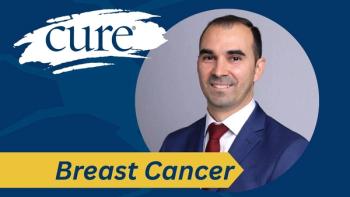
Navigating the Ins and Outs of Implant Reconstruction After Breast Cancer Surgery

Different breast implant options and potential complications may make the reconstruction process difficult to understand, but one expert discusses the importance of knowing what you want and hopefully avoiding postsurgical issues.
Women with breast cancer who undergo surgery as part of their treatment may also undergo implant-based reconstruction, which can come with its own set of options and complications.
Dr. Liza C. Wu, a professor of surgery at the Hospital of the University of Pennsylvania and Children’s Hospital of Philadelphia, presented on the topic at the 12th Annual Joining Forces Against Hereditary Cancer Conference. During her presentation, she highlighted the advantages and disadvantages of options available for breast reconstruction, in addition to some postsurgical complications that may occur.
Typically, implant-based reconstruction is performed in two stages. First, a mastectomy is performed by a breast surgeon and a tissue expander is placed into the breast pocket by a plastic surgeon. The patient then undergoes a series of expansions on a weekly basis to stretch overlying tissues, which creates room for the breast implant. The second stage involves another surgery to remove the tissue expander and replace it with the implant.
“There are certain advantages and disadvantages to this two-stage expander implant reconstruction,” Wu said during the presentation. “Advantages include that it allows the tissue to recover after the mastectomy, it allows the patient to control the expansion process and it also allows the patient to choose the size. Disadvantages is the expansion process takes time. It also has two separate surgeries to achieve the outcome.”
In contrast, some women may be candidates for a one-stage, direct-to-implant reconstruction. At the time of the mastectomy, a plastic surgeon comes in to place a full-size implant without the need for a tissue expander. Although the advantage of this approach is that it only requires one surgery, there are several disadvantages, one of which is that it cannot be performed in women with mastectomy skin flaps that are very thin or compromised. This also cannot be done in patients who want larger breasts than they had before the surgery, nor in those who smoke or patients who were previously treated with radiation.
Types of Breast Implants
Breast implants can have several differentiating characteristics which may help patients and their surgeons decide what’s best for them. For example, an implant, which is a silicone shell, can be filled with a silicone polymer or saline. Silicone implants feel and look more natural with less rippling, and saline implants are known to be firmer than silicone.
“The difference between the two mostly comes when the implant ruptures,” Wu said. “When a saline implant ruptures, your body absorbs the saltwater. When a silicone implant ruptures, your body does not absorb the silicone. The silicone typically stays within the capsule of the breast implant.”
“The cancer is found within the capsule around the implant,” Wu explained. “It is not your typical breast cancer. It’s more of a lymphoma. It can present as a swelling or a mess, and it is likely associated with textured implants. Your risk of developing
Wu added that a woman’s risk for developing breast cancer, if they are not genetically predisposed to it, is approximately 1 in 8. Anaplastic large-cell lymphoma can be treated with surgery to remove the affected implant and capsule and potentially with chemotherapy.
Patients can also choose the shape of their breast implants. They can either be round, which is completely symmetric in all degrees, or shaped like a teardrop. A teardrop-shaped implant can lead to a more natural look. The volume of the breast implant can also be customized, giving the patient the ability to choose their size. Although implants are prefilled, they can range anywhere between 100 cubic centimeters (or CCs) and 800 CCs. Patients can select the projection — low profile to extra-high profile — and diameter of the implant, which is often determined based on the size of the chest wall.
Wu explained how the implant can be positioned in two different locations: underneath the muscles of the chest or on top of those muscles.
“Traditionally, implants were placed underneath the muscles of the chest because it was believed that this would protect the implant from something called capsular contracture, or hardening of the scar tissue around the implant,” Wu said. “With the development of special material called acellular dermal matrix, we are now able to place the implant on top of the muscle if the surgeon leaves you a very healthy breast envelope.”
There are several advantages and disadvantages to both implant placement options. When placed behind the muscle, the implant is more protected and secure, which may lead to lower rates of infection and capsular contracture. If the implant is placed on top of the muscle, a patient does not have to undergo muscle dissection, which then results in less postoperative pain. Placing the implant on top of the muscle may also lead to animation deformity, which is what happens when skin scars down to the underlying muscle. When it contracts, the skin wrinkles on top of the muscle.
Potential Surgical Complications
Patients may face several challenges after undergoing a mastectomy including mastectomy flap necrosis. This occurs when a breast gland is removed and the overlying breast skin is thin, damage and does not have a good blood supply, leading to the death of cells or tissue.
“If this happens, it is very difficult to be able to maintain either an expander or implant in the pocket,” Wu said. “This can be fixed by either removing the dead skin and placing either a smaller implant or maybe even a tissue expander into the pocket, letting things heal and then continuing with the process subsequent to that.”
Seroma is another potential complication related to mastectomy. This relates to a build-up of clear fluids where the breast tissue was removed, and can occur if drains in the breast pocket are removed too early or are not doing their job. The fluid can be drained with a needle through the skin. Another option is to wrap the patient, which allows the body to reabsorb the fluid.
Implant malposition is a complication that may occur after placement. This is when the implant slips out of the breast pocket, causing the implant to sit lower than where it should be.
“This can be corrected by going in and surgically removing the implant, reestablishing the fold underneath the breast called the inframammary fold and hiking up the implant typically using the acellular dermal matrix,” Wu said.
For patients that undergo a nipple-sparing mastectomy, where the nipple and areola are left intact, nipple malposition may occur. This is when the nipple migrates to a different portion of the breast and can be very difficult to overcome.
“And if it's that bothersome, some may even recommend removing the nipples and then having them tattooed into the correct position,” Wu said.
The rate of implant rupture is 1% per year, which increases to 10% to 15% at 10 years, depending on the manufacturer. After 10 years, the risk of rupture continues to increase, and surgeons tell their patients that implants can last approximately 10 to 15 years.
“If you have a silicone implant, you may not see a change in your implant,” Wu said. “That's why it's very important to continue to follow with your plastic surgeon and potentially get imaging to show whether your implant is intact.”
Implant contracture is when scar tissue forms around the breast implant, leading it to become hard and heavy. This can cause a deformity in the breast reconstruction and may also cause pain. To overcome this issue, a surgeon has to remove the implant and scar tissue and replace it with another implant.
“It can happen with any type of breast implant silicone, saline, smooth, textured, round or teardrop,” Wu said. “Breast implant illness is actually not recognized as an official medical diagnosis; however, (it) has been reported by thousands of women. When these implants are removed in these women, not all the symptoms may go away, pointing to the fact that breast implant illness may be caused by multiple factors.”
For more news on cancer updates, research and education, don’t forget to





